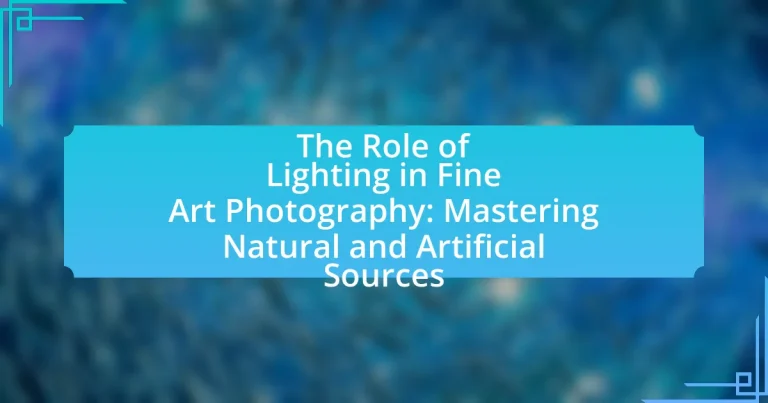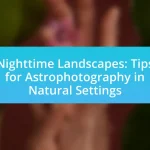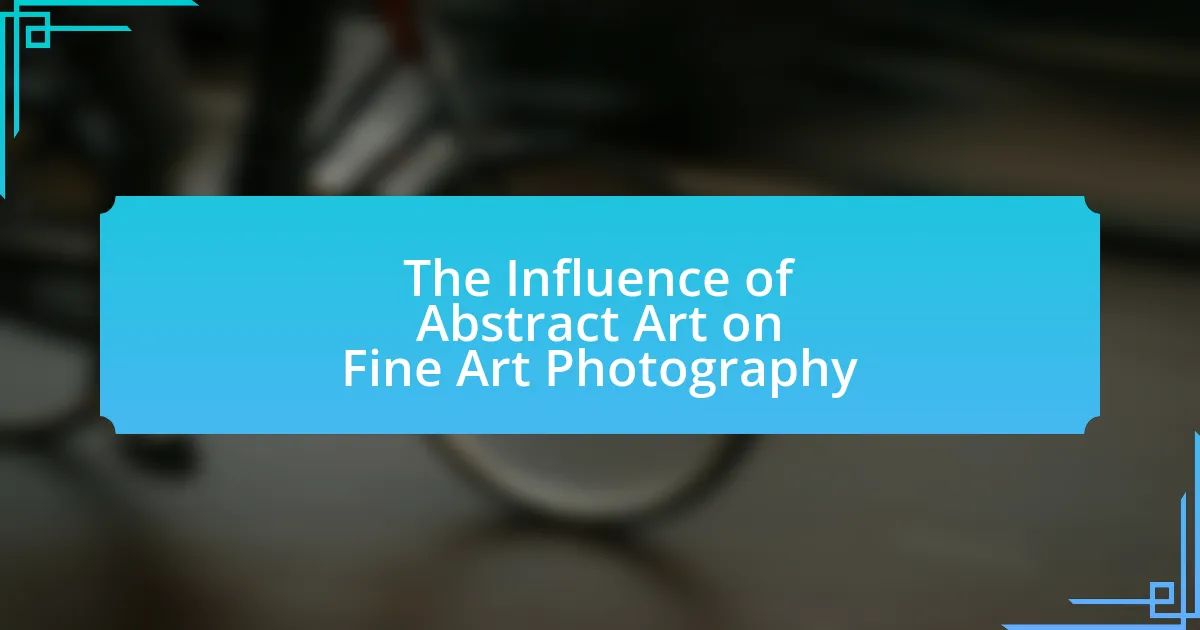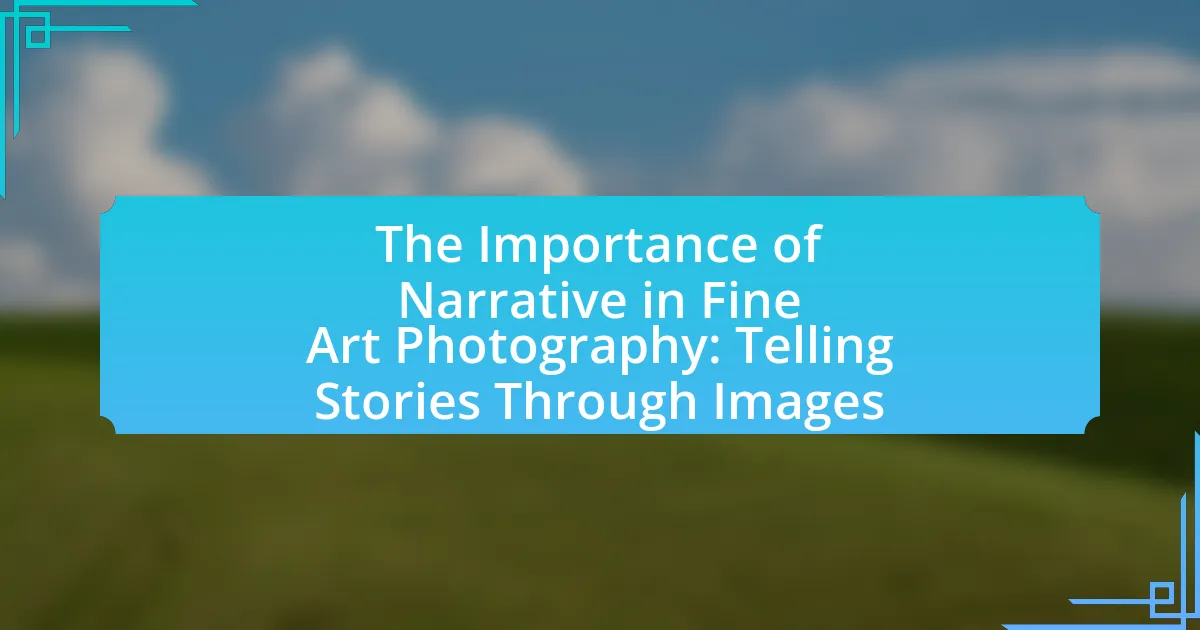The article focuses on the critical role of lighting in fine art photography, emphasizing the importance of both natural and artificial light sources. It explores how lighting influences mood, composition, and viewer perception, detailing key elements such as direction, quality, color, and intensity. The discussion includes techniques for managing various lighting conditions, overcoming challenges, and effectively combining light sources to enhance artistic expression. Additionally, it provides practical tips for photographers to improve their lighting skills and resources for further learning on lighting techniques.

What is the Role of Lighting in Fine Art Photography?
Lighting plays a crucial role in fine art photography by shaping the mood, enhancing textures, and defining the subject. The quality, direction, and color of light can dramatically influence the visual narrative of an image. For instance, soft, diffused lighting can create a serene atmosphere, while harsh, direct light can evoke tension or drama. Studies have shown that the manipulation of light can alter perception; for example, the use of chiaroscuro, a technique that contrasts light and shadow, has been employed by artists since the Renaissance to add depth and dimension to their work. Thus, understanding and mastering lighting is essential for photographers aiming to convey specific emotions and artistic intentions in their fine art photography.
How does lighting influence the overall composition in fine art photography?
Lighting significantly influences the overall composition in fine art photography by shaping the mood, highlighting subjects, and creating depth. The direction, quality, and color of light can alter the perception of textures and forms, guiding the viewer’s eye and emphasizing focal points within the frame. For instance, soft, diffused lighting can evoke a sense of calm, while harsh, direct lighting can create dramatic contrasts and tension. Studies have shown that the use of natural light, such as during the golden hour, enhances the aesthetic appeal of images by providing warm tones and soft shadows, which contribute to a more engaging composition.
What are the key elements of lighting that affect composition?
The key elements of lighting that affect composition include direction, quality, color, and intensity. Direction determines how light falls on subjects, influencing shadows and highlights, which can create depth and dimension. Quality refers to the softness or hardness of light; soft light minimizes shadows, while hard light creates stark contrasts. Color affects the mood and tone of the image, with different colors evoking various emotional responses. Intensity, or brightness, impacts visibility and can draw attention to specific areas within the composition. These elements collectively shape the visual narrative and aesthetic appeal of a photograph.
How does the direction of light impact the mood of a photograph?
The direction of light significantly impacts the mood of a photograph by influencing shadows, highlights, and overall tonal quality. For instance, front lighting tends to create a flat and even appearance, which can evoke a sense of calmness or neutrality. Conversely, side lighting introduces depth and texture, often generating a dramatic or moody atmosphere due to the interplay of light and shadow. Backlighting can create silhouettes, imparting a sense of mystery or nostalgia. Studies in photography demonstrate that the angle of light affects emotional responses; for example, low-angle light during golden hour is often associated with warmth and tranquility, while harsh overhead lighting can evoke tension or discomfort.
Why is understanding natural and artificial lighting essential for photographers?
Understanding natural and artificial lighting is essential for photographers because it directly influences the quality, mood, and clarity of their images. Photographers must master these lighting types to effectively control exposure, highlight subjects, and create desired atmospheres in their work. For instance, natural lighting varies throughout the day, affecting color temperature and shadow intensity, while artificial lighting allows for consistent control over brightness and direction. Studies show that photographers who adeptly manipulate lighting can enhance visual storytelling, as evidenced by the significant impact of lighting on viewer perception and emotional response in photography.
What are the differences between natural and artificial lighting?
Natural lighting comes from the sun and varies in intensity and color throughout the day, while artificial lighting is generated by man-made sources such as bulbs and LEDs. Natural light provides a broad spectrum of colors and shadows that change with the time of day, which can enhance the mood and depth in fine art photography. In contrast, artificial lighting offers consistency and control over brightness and color temperature, allowing photographers to create specific effects and settings regardless of external conditions. The differences in source, variability, and control between natural and artificial lighting significantly impact the aesthetic and technical aspects of fine art photography.
How can photographers effectively combine both lighting sources?
Photographers can effectively combine both lighting sources by balancing the intensity and color temperature of natural and artificial light. This involves using reflectors or diffusers to soften harsh artificial light and adjusting the exposure settings on the camera to harmonize the two light sources. For instance, when shooting outdoors during golden hour, a photographer can use a flash to fill in shadows without overpowering the warm natural light, creating a cohesive look. Studies show that proper blending of light sources enhances the depth and dimension of images, making them more visually appealing.
What are the common challenges photographers face with lighting?
Photographers commonly face challenges with lighting, including inconsistent natural light, harsh shadows, and the difficulty of balancing multiple light sources. Inconsistent natural light can result from changing weather conditions or time of day, affecting exposure and color accuracy. Harsh shadows often occur in direct sunlight, leading to unflattering contrasts on subjects. Additionally, balancing multiple light sources, such as mixing artificial lights with natural light, can create color temperature discrepancies, complicating the overall lighting setup. These challenges require photographers to adapt their techniques and equipment to achieve desired results in their work.
How can harsh lighting conditions be managed in fine art photography?
Harsh lighting conditions in fine art photography can be managed by utilizing diffusers, reflectors, and adjusting the shooting time. Diffusers soften the light, reducing harsh shadows and highlights, while reflectors can bounce light to fill in shadows, creating a more balanced exposure. Additionally, shooting during the golden hour, shortly after sunrise or before sunset, provides softer, warmer light that enhances the overall aesthetic of the photograph. These techniques are supported by the principles of light manipulation in photography, which emphasize the importance of controlling light quality to achieve desired artistic effects.
What techniques can be used to overcome low-light situations?
To overcome low-light situations in photography, techniques such as increasing the ISO setting, using a wider aperture, and employing longer exposure times can be effectively utilized. Increasing the ISO enhances the camera’s sensitivity to light, allowing for better performance in dim conditions; for instance, modern cameras can often handle ISO settings of 3200 or higher with minimal noise. Using a wider aperture, such as f/1.8 or f/2.8, allows more light to enter the lens, which is crucial in low-light environments. Additionally, longer exposure times can capture more light, but this requires a stable camera setup, often achieved with a tripod, to prevent motion blur. These methods are widely recognized in photography as essential strategies for managing low-light challenges.
How can photographers master the use of natural light?
Photographers can master the use of natural light by understanding its qualities, such as direction, intensity, and color temperature, and by practicing techniques to manipulate these elements effectively. For instance, shooting during the golden hour, which occurs shortly after sunrise and before sunset, provides soft, diffused light that enhances the subject’s features and colors. Additionally, using reflectors can help bounce light onto the subject, filling in shadows and creating a more balanced exposure. Studies show that photographers who adapt their shooting techniques to the time of day and weather conditions can significantly improve their images, as natural light varies greatly throughout the day.
What are the best times of day for utilizing natural light?
The best times of day for utilizing natural light are during the golden hour, which occurs shortly after sunrise and just before sunset. During these periods, the sunlight is softer and warmer, creating ideal conditions for fine art photography. Research indicates that the angle of the sun during these times enhances colors and reduces harsh shadows, making subjects appear more visually appealing.
How does weather affect the quality of natural light?
Weather significantly affects the quality of natural light by altering its intensity, color temperature, and diffusion. For instance, on clear days, sunlight is direct and harsh, resulting in high contrast and vibrant colors, which can be ideal for certain photography styles. Conversely, overcast conditions diffuse sunlight, softening shadows and reducing contrast, which can enhance details and create a more even lighting effect, beneficial for portrait and landscape photography. Additionally, atmospheric conditions such as rain or fog can introduce unique lighting qualities, such as a cooler color temperature or a muted palette, which can evoke specific moods in fine art photography.
What techniques can enhance the use of artificial lighting?
Techniques that can enhance the use of artificial lighting include the use of diffusers, reflectors, and adjustable light sources. Diffusers soften the light, reducing harsh shadows and creating a more even illumination, which is essential in fine art photography to maintain the integrity of the subject. Reflectors can bounce light back onto the subject, filling in shadows and adding dimension, which is particularly useful for highlighting textures and details. Adjustable light sources, such as LED panels or strobes, allow photographers to control the intensity and direction of light, enabling them to create specific moods and effects that align with their artistic vision. These techniques are widely recognized in photography for their effectiveness in achieving professional-quality results.
What types of artificial lighting are most effective for fine art photography?
The most effective types of artificial lighting for fine art photography include softboxes, ring lights, and LED panels. Softboxes diffuse light, creating a soft and even illumination that reduces harsh shadows, making them ideal for portrait and still life photography. Ring lights provide uniform lighting and are particularly useful for macro photography and portraits, as they minimize shadows on the subject’s face. LED panels offer versatility in color temperature and intensity, allowing photographers to achieve specific moods and effects in their compositions. These lighting types are widely used in the industry due to their ability to enhance the visual quality of fine art images.
How can modifiers improve the quality of artificial light?
Modifiers can improve the quality of artificial light by altering its intensity, direction, and diffusion. By using modifiers such as softboxes, umbrellas, or reflectors, photographers can soften harsh light, reduce shadows, and create a more even illumination on subjects. For instance, softboxes diffuse the light source, resulting in a softer, more flattering light that enhances textures and details in fine art photography. This technique is supported by studies showing that diffused light can reduce contrast and create a more aesthetically pleasing image, which is crucial in fine art contexts.
What are the best practices for balancing natural and artificial light?
The best practices for balancing natural and artificial light involve using a combination of techniques to achieve a harmonious lighting effect. Photographers should assess the color temperature of both light sources, ensuring they match or complement each other; for instance, using a color temperature meter can help determine the right balance. Additionally, adjusting the intensity of artificial light to match the natural light levels is crucial; this can be done by using dimmers or adjusting the distance of the light source. Utilizing reflectors can also enhance natural light, directing it to the subject while minimizing harsh shadows created by artificial sources. Finally, employing a light meter to measure exposure levels ensures that both light types are effectively balanced, resulting in a cohesive image.
How can exposure settings be adjusted for mixed lighting conditions?
To adjust exposure settings for mixed lighting conditions, photographers should utilize a combination of manual settings and metering techniques. Specifically, they can adjust the aperture, shutter speed, and ISO to balance the different light sources effectively. For instance, using a lower ISO can reduce noise in bright areas, while adjusting the aperture can control depth of field and light intake. Additionally, employing spot metering allows for precise exposure readings from specific areas, helping to manage the influence of varying light temperatures. This method is supported by the fact that mixed lighting often results in uneven exposure, necessitating careful adjustments to achieve a balanced image.
What tools can assist in achieving the right balance of light?
Tools that can assist in achieving the right balance of light include light meters, reflectors, diffusers, and adjustable lighting systems. Light meters measure the intensity of light in a scene, ensuring proper exposure settings for both natural and artificial light sources. Reflectors bounce light onto subjects, filling in shadows and enhancing overall illumination. Diffusers soften harsh light, creating a more even distribution and reducing glare. Adjustable lighting systems, such as LED panels or studio strobes, allow photographers to manipulate light intensity and direction, providing greater control over the final image. These tools are essential for fine art photography, where precise lighting can significantly impact the aesthetic quality of the work.
What practical tips can photographers apply to improve their lighting skills?
Photographers can improve their lighting skills by mastering the use of natural light and understanding artificial lighting techniques. Utilizing the golden hour, which occurs shortly after sunrise and before sunset, allows photographers to capture soft, warm light that enhances the subject’s features. Additionally, experimenting with reflectors can help bounce light onto the subject, reducing harsh shadows and creating a more balanced exposure.
Understanding the exposure triangle—aperture, shutter speed, and ISO—enables photographers to manipulate light effectively for desired outcomes. For instance, a wider aperture allows more light to enter the camera, which is beneficial in low-light situations.
Moreover, learning to use artificial lighting sources, such as speedlights or studio strobes, can provide greater control over lighting conditions. Techniques like softening light with diffusers or adjusting the light’s direction can significantly impact the final image.
Research indicates that photographers who actively practice these techniques see a marked improvement in their ability to manipulate light creatively, leading to more compelling images.
How can experimenting with different lighting setups enhance creativity?
Experimenting with different lighting setups enhances creativity by allowing artists to explore various moods, textures, and visual narratives in their work. Different lighting conditions can dramatically alter the perception of a subject, enabling photographers to discover unique compositions and emotional impacts. For instance, high-contrast lighting can create dramatic shadows that emphasize form, while soft, diffused light can evoke a sense of calm and intimacy. Research indicates that varying light sources, such as natural sunlight versus artificial studio lights, can lead to distinct artistic outcomes, as demonstrated in studies on visual perception and emotional response to imagery. This exploration not only broadens an artist’s technical skills but also stimulates innovative thinking, ultimately enriching their creative expression.
What resources are available for learning more about lighting techniques?
Books, online courses, and tutorials are valuable resources for learning about lighting techniques. Notable books include “Light, Science & Magic” by Fil Hunter, which provides a comprehensive understanding of lighting principles, and “The Photographer’s Guide to Lighting” by Michael Freeman, which offers practical insights into both natural and artificial lighting. Online platforms like MasterClass and Skillshare feature courses taught by professional photographers, covering various lighting techniques in detail. Additionally, YouTube channels such as “The Slanted Lens” and “Adorama” provide free tutorials and demonstrations on lighting setups and techniques, making them accessible for learners at all levels.

















